Related Research Articles

The Porsche 962 is a sports-prototype racing car built by Porsche as a replacement for the 956 and designed mainly to comply with IMSA's GTP regulations, although it would later compete in the European Group C formula as the 956 had. The 962 was introduced at the end of 1984, from which it quickly became successful through private owners while having a remarkably long-lived career, with some examples still proving competitive into the mid-1990s. The vehicle was later replaced by the Porsche WSC-95.

The World Sportscar Championship was the world series run for sports car racing by the FIA from 1953 to 1992.

The 1994 24 Hours of Le Mans was the 62nd Grand Prix of Endurance, and took place on 18 and 19 June 1994.
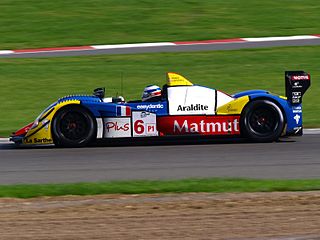
Courage Compétition was a racing team and chassis constructor company now owned by Oreca, based in Le Mans, France near the Circuit de la Sarthe. It was founded by Yves Courage, a French race driver who ran hillclimbs before founding the company. Following the purchase of Courage by Oreca in 2007, Yves Courage has refounded the company as Courage Technology in 2010, attempting to develop electric racing cars.

The Acura ARX-01, later known as the HPD ARX-01 is a series of Le Mans Prototype built for sports car racing, specifically in the American Le Mans Series, Le Mans Series, and at the 24 Hours of Le Mans. It is the first purpose-built race car by the Acura division of Honda Motor Company, part of their multi-year program to eventually compete in endurance race. The car debuted in 2007 in the American Le mans Series before expanding to customers in Europe. Over the years various specifications of the ARX-01 chassis have been developed, each signified by a letter suffix. In 2010 Acura withdrew their name from the program and Honda Performance Development which developed the car for Acura continued the program into 2011.

Porsche has been successful in many branches of motorsport of which most have been in long-distance races.
Richard Lloyd Racing (RLR), originally named GTi Engineering, was a British auto racing team created in 1977 by driver Richard Lloyd. Originally named for the Volkswagen Golf GTIs that Lloyd raced in the British Saloon Car Championship (BSCC), they went on to become a successful Porsche privateer in the World Sportscar Championship (WSC). Richard Lloyd Racing eventually folded at the end of the 1990 season due to the increased cost of the World Championship.
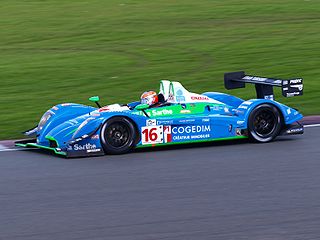
The Pescarolo 01 is the first sports prototype racing car built entirely by French team Pescarolo Sport. It is designed to meet the LMP1 and LMP2 regulations for Le Mans Prototypes in the Le Mans Series as well as at the 24 Hours of Le Mans, and replace Pescarolo's previous C60 chassis which had been heavily modified from cars purchased through Courage Compétition. The first 01s debuted at the 2007 1000 km of Monza.
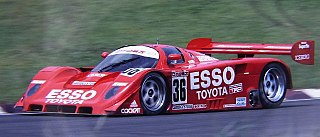
The Toyota 92C-V was a prototype racing car built by Toyota as a Group C car, and later as a LMP car. It raced in the 24 Hours of Le Mans for three years. It also took part in the final year of the All Japan Sports Prototype Championship during the 1992 season.
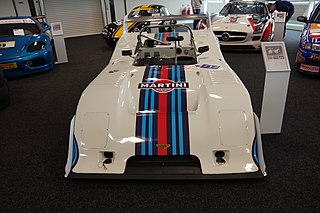
The Chevron B31 was a sports prototype racing car built by Chevron Cars Ltd in 1975, and initially used in the European 2-Litre Championship. The car was an evolution of the Chevron B26, and was initially fitted with a 2-litre Hart 420R straight-four engine producing 290 hp. However, various other engines were used; the car also ran with engines such as the 3-litre Cosworth DFV V8, the 2-litre Cosworth FVD/Cosworth BDG straight-four engines, and the 2-litre BMW M12 straight-four, amongst others.

The Rondeau M382 was a Group C prototype sports car, designed, developed and built by Automobiles Jean Rondeau in 1981, and used in sports car racing between 1982 and 1986.
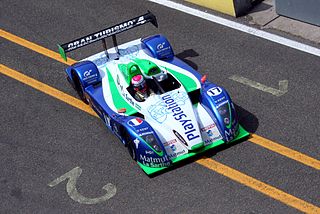
The Courage C60 was a Le Mans Prototype (LMP) racing car built by Courage Compétition in 2000, and used in international sports car races until 2006. A replacement for the Courage C52, it was Courage's first all-new prototype since the Courage C41 was built in 1994.

The Courage C30, also known as the Courage C30LM, was a Group C2 sports prototype, designed, developed and built by French manufacturer Courage in 1993. It famously contested in the 1993 24 Hours of Le Mans, with drivers Derek Bell and Pierre Yver finishing in 10th and 11th place, respectively.

The Courage C36 was a Le Mans Prototype, designed, developed, and built by Courage Compétition team, to compete in sports car racing from 1996 to 1998. It is powered by a 3.0 L (180 cu in) 700 hp (520 kW) Porsche flat-six engine. Its best result was a 3rd-place finish at the 1997 FIA Sportscar Championship race at Zolder.
The Cougar C22 was a Group C sports car prototype used in the World Sports-Prototype Championship sports car racing series, from 1988 to 1989.

The Cougar C28 was a Group C sports car prototype build by Courage. It was used in the World Sports-Prototype Championship sports car racing series in 1992. Power came from a 3.0-liter Porsche 6-cylinder turbocharged engine. It managed to achieve an impressive 3 podium finishes and 1 class win. Highlights include an overall 6th-place finish at that year's prestigious 24 Hours of Le Mans, two third-place finishes and a sixth-place finish for Tomas Saldaña at the Interserie races in Jarama, Zeltweg, and Brands Hatch (respectively), and a third-place finish for Marco Brand at the Interserie race in Mugello.
The Cougar C12 was a Group C sports car prototype race car, designed, developed and built by French constructor Cougar in 1985, and used in sports car racing from 1985 to 1988. Its best result was an 18th-place finish at the 1986 24 Hours of Le Mans, being driven by Yves Courage, Alain de Cadenet, and Pierre-Henri Raphanel.

The Toyota 87C, also known as the TOM'S 87C, was a Group C prototype sports car, designed, developed and built by Toyota, for use in sports car racing, specifcally the World Sportscar Championship, between 1987 and 1988.
The Welter-Meunier P82, and its successors and derivatives, including the P83, the P83B, and the P86, are a series of mid-engined Group C sports prototype race cars, designed, developed and built by French racing team Welter Racing, for sports car racing, between 1982 and 1986. The cars best result was a 6th-place finish at the 1982 1000km of Monza, being driven by Roger Dorchy, Guy Fréquelin, and Jean-Daniel Raulet. It was powered by a Garrett twin-turbocharged, 2.7 L (160 cu in), Peugeot PRV, V6 engine, producing between 600–890 hp (450–660 kW) @ 8300 rpm, depending on boost pressure, which drove the rear wheels through a 5-speed manual transmission. The chassis design was constructed into an aluminum monocoque, and the car weighed approximately 900 kg (2,000 lb).

The Courage LC70 is a Le Mans prototype of the LMP1 class developed by Courage Competition and used in sports car racing since 2006. In the meantime, however, Courage Compétition has been taken over by ORECA, so the original name Courage LC70 has been changed. The Courage-ORECA LC75 is almost identical in construction but was designed for the LMP2 class. Other modifications of the LC75 are the Acura ARX-01a and Acura ARX-01b, which has been used in the American Le Mans Series since 2007. The type designation LC stands for Lillian Courage, the wife of Yves Courage who died in 2004.
References
- ↑ Smith, Roy P. (October 13, 2021). Powered by Porsche - the alternative race cars. Veloce Publishing Ltd. ISBN 9781787118058 – via Google Books.
- ↑ "World Sports Racing Prototypes - World Championship 1988". www.wsrp.cz.
- ↑ "Cougar C20" . Retrieved 13 June 2022.
- ↑ "Cougar C20B" . Retrieved 13 June 2022.